Whale sharks (in Vietnamese: Ca Ong, literally “Sir Fish”), have been in the headlines quite a bit lately. Here’s a roundup:
WA WS, OK?
A whale shark was seen far from home back in January; it was around Perth, the capital of Western Australia. Now WA is home to probably the best characterised whale shark site on the planet, Ningaloo Reef, but WA is a vast, VAST state, and Perth is a long way from Ningaloo. Like, 900 miles or almost 10 degrees of latitude. The animal appeared to be fine, but did lead to the incidental closing of a beach for a while, presumably while they tried to work out what sort of shark they were dealing with. I don’t think there’s anything too unusual about this; whale sharks are highly migratory and there’s no reason why, given the right oceanographic conditions, a whale shark might not go a long way south of the tropics, as it did in this case. Certainly basking sharks – generally considered a coldwater species – have recently been documented traveling a lot further into the tropics than anyone expected, even crossing the equator.
Queensland cowboys
Also in January, some fishermen were silly enough to (a) ride a whale shark and (b) get filmed doing it, off the coast of Queensland. Now, in their defence the animal didn’t seem too bothered by them, and I understand their exuberance at seeing one of the worlds most amazing animals, but there are a bunch of reasons why this isn’t a good idea. Firstly, it’s dangerous to the humans. In my experience the tail of whale sharks is the bit you need to look out for and if you don’t know what you’re doing they can really hurt you. Secondly, why harass the thing anyway? It’s minding it’s own business, why do you have to turn it into a carnival ride to enjoy it? Isn’t it enough to have the animal approach your boat and be in its presence for a while? My guess is that it would have hung around longer had they not leaped in the water with it. This was quite a small animal (probably 5m, not the 7 quoted in the article) and, interestingly, we see a bit of a trend towards younger animals being inquisitive and even playful sometimes. One colleague I know was hounded while snorkeling by a little 3.5m animal for nearly 20 minutes, he just loved her! That does NOT mean, however, that we ought to try and play with whale sharks every time we see them. Like any wild animal, things can turn ugly in a hurry and you don’t want to be on the business when you startle them and that tail comes a-swinging. A good philosophy: Take only photos, leave only ripples…
Cendrawasih chow-down
Lots of people forward me the news stories and exquisite pics of whale sharks being hand fed by fishermen in West Papua at Cendrawasih Bay, which is part of the Birds Head seascape of marine protected areas where Conservation International and WWF have been doing a lot of work. Again, I don’t think this is a good idea (the whale shark feeding, not the MPAs!). Even if the interaction came about naturally when whale sharks began to suck on creel nets full of bait fish, it should not be encouraged. Like any wild animal, you don’t want them to become dependent on humans for food, nor have them lose a healthy wariness of human populations. That can only lad to injury for both whale sharks and people. It has been acknowledged that the presence of whale sharks in Cendrawasih is an ecotourism opportunity, and that may be so, but baiting whale sharks is no different than baiting any other predator (size differential and dentition are really irrelevant) and I think should be avoided. Hubbs Institute senior researcher Brent Steward has also suggested caution and encouraged the implementation of a code of conduct for WS interactions at Cendrawasih. Bravo Brent.
New WS ecotourism opens up in Cebu, Philippines

Swimming with whale sharks in Oslob, Cebu province in the Philippines has exploded onto the ecotourism scene. It’s so exciting when a new opportunity opens up for people to experience whale sharks in their natural environment, but the bad news is that, like the Cenderawasih situation, Oslob is not a natural aggregation observed from a distance but an artificial aggregation encouraged by hand feedings from fishermen. In Oslob, whale sharks began approaching outriggers and were subsequently “encouraged” with hand-feedings of shrimp such that they are now a regular feature and reliable enough to build businesses around. I’ve followed the search term “whale shark” on TweetDeck since I first started with social media and I can tell you that just in the last 6 months that column has become 75% Cebu whale shark talk, and a lot of it is from native Filippinos flocking to the area to experience the Oslob animals. There’s some good news here in that the government has moved quickly to help regulate the ecotours; there are rules (not guidelines) in place concerning how many boats can go out, how much time they can spend and how many people can go in the water, and these are pretty stringent, which is good. No doubt the many lessons of whale shark ecotourism in nearby Sorsogon province, which is a very popular whale shark ecotourism site, have helped in this regard. I only hope Cenderawasih and other locations where whale sharks aggregate can be as responsible. That said, I question the underlying process (baiting) by which this cottage industry came about and I sincerely hope it doesn’t become a trend, or that if it does, people vote with their tourist dollars to avoid it, like other shark baiting experiences. Shawn Heinrichs points out that the killing of whale sharks for meat elsewhere in the Philippines and beyond is a bigger deal, and he may be right, but I still think we ought to be good when we can and not dismiss baited ecotourism as harmless just because its not the worst thing out there.
The largest whale shark ever filmed?
The Towsnville Bulletin in Australia ran the wishful headline “Is this the largest whale shark caught on camera?”. The short answer is no, not even close. In fact, it’s pretty average; I’d estimate 7m, not the 12 that the fishermen guess. Right, that’s enough attention for that bit of rubbish…
The Big One, literally
The greatest amount of well-intended “Hey Al, did you see this?” email I’ve received recently, however, has been reserved for the big whale shark in Karachi, Pakistan. What a story it is too, with it’s fair share of drama and characters! The TL;DR is that a very large whale shark was “collected” off the coast of Pakistan and brought to the fishing docks, where chaos ensued. This photo from the LA Times story

On Feb 8, the LA Times reported that the animal, which was around 40 feet long and weighed at least 15,000lbs, was “found dead in shallow water”, but on the same day the UK’s Guardian, quoting a fisherman, reported that the animal “was found alive entangled in the nets of a passing trawler” and died 4 hours later. The CSM reported the boat’s owner saying that “It was dead when my men found it”. You’re all going to have to forgive my skepticism, but I have to call BS on all this. These sorts of conflicting accounts are a huge red flag to any detective. There are penalties for killing a whale shark deliberately, the notion that a “passing trawler” didn’t notice 8 tons of meat accidentally tangled in their net stretches plausibility beyond it’s limits, and in the Guardian report the fisherman states that the shark was caught on a hook and then became tangled in the nets. I think it’s much more likely that this animal was simply captured, deliberately or otherwise (probably deliberately), and then they brought it back to port to see what they could get for it. I’m happy to be proven wrong, but if it walks like a duck…
See the Guardian video (no embedding, sorry)
Chaotic scenes unfolded dockside as locals crammed around the body of the whale shark and kids climbed on it like a giant spotty jungle gym. Soon enough someone saw a business opportunity and the carcass was snapped up by an entrepreneurial sort named either Haji Qasim or Qasim Khan, depending on whom you ask, for about two grand US. He then erected a pipe and drape around it and began charging 20 rupees a pop for people to see the thing, even though by this time it was starting to smell pretty foul. After a while, the police got involved and tried to make sure people could see it for free, and a bit of cat and mouse ensued between Mr. Khan and the Fuzz, which you can read about here. This photo of a man standing on top of the carcass is from the Tribune, see the rest of the story here:

Eventually the specimen found its way to the Pakistani Museum of Natural History in Islamabad where it will become part of their collection. I don’t know what happened to the rest of it, but this pretty much looks like skin to me. While I’m happy that the animal will become part of a museum collection, it was in pretty sorry state by the time it got there so it will likely not make the best of displays, if indeed that is their aim. Either way, it’s a tragic and pretty ignoble end for what was an amazing animal.

So that’s all the whale shark news that’s fit to print this winter/spring. I’ll doubtless revisit my favourite spotty fiends as summer approaches and we gear up for our annual research activities in Mexico. In the meantime, are you following @Wheres_Domino on Twitter? Cos, you know, you should…and stuff…

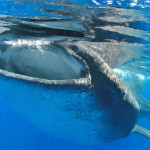
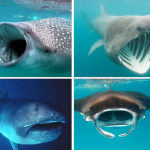
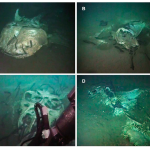
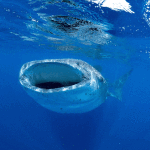
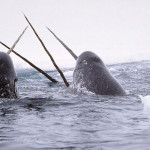
3 Replies to “Sir Fish grabbing headlines, but it’s not all good”
Comments are closed.